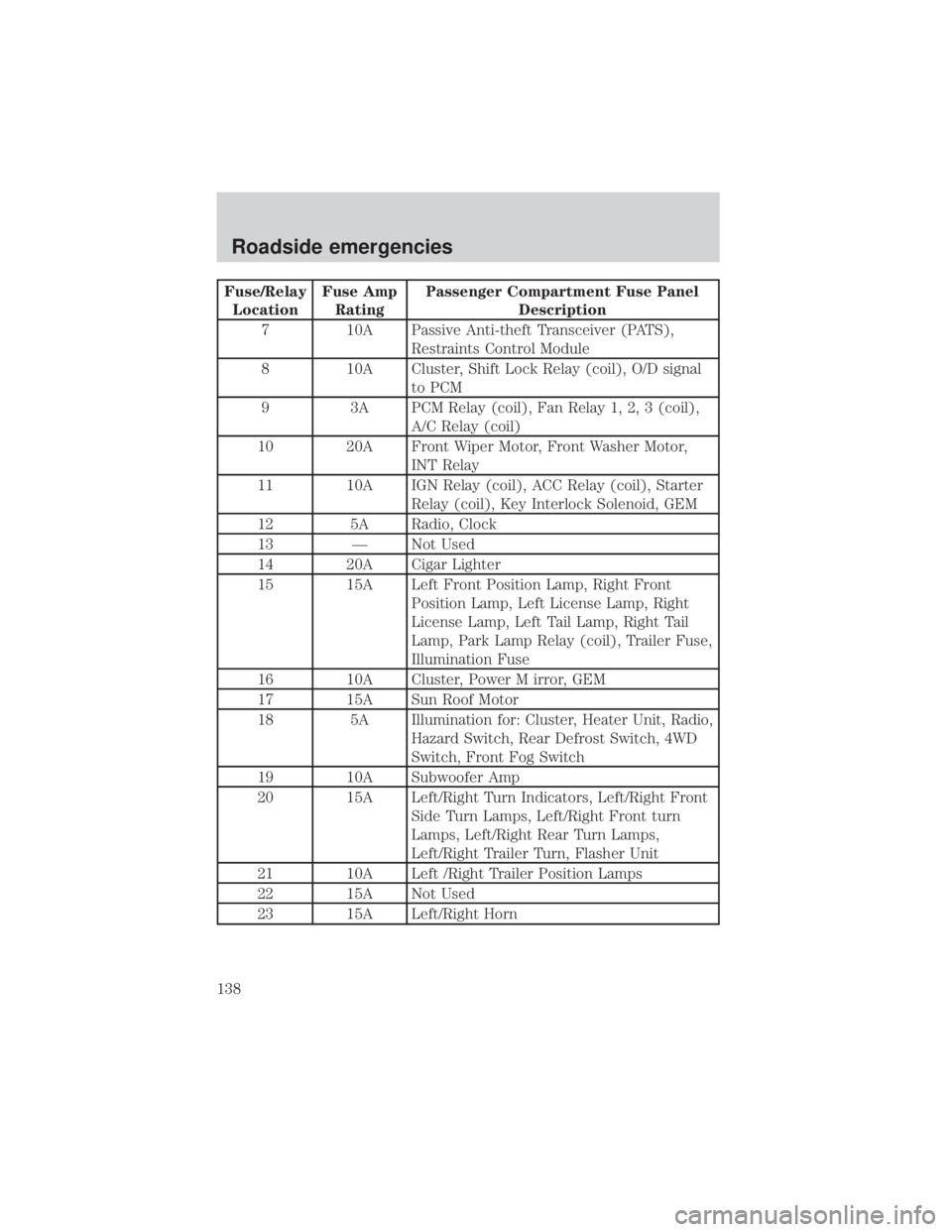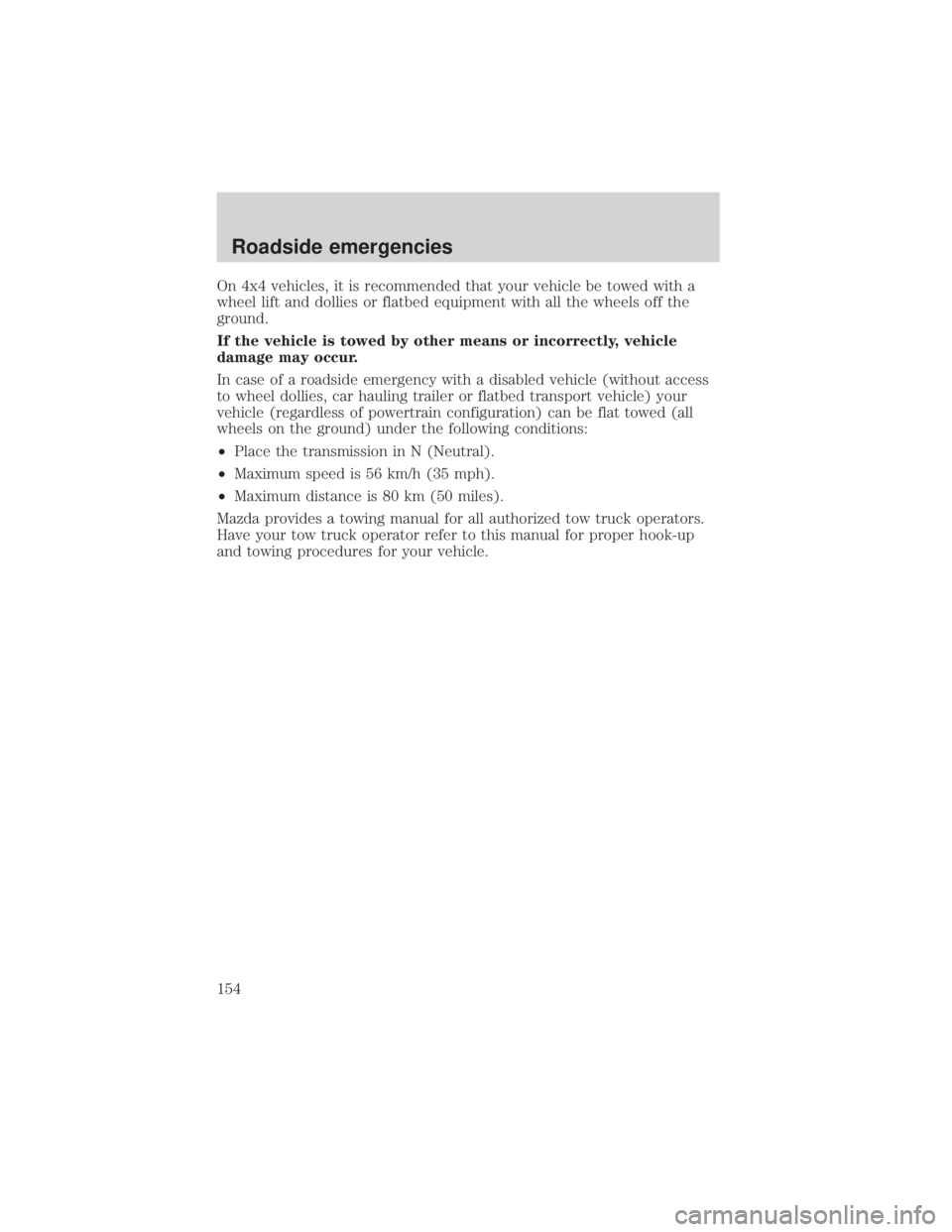2001 MAZDA MODEL TRIBUTE 4WD trailer
[x] Cancel search: trailerPage 138 of 232

Fuse/RelayLocation Fuse Amp
Rating Passenger Compartment Fuse Panel
Description
7 10A Passive Anti-theft Transceiver (PATS), Restraints Control Module
8 10A Cluster, Shift Lock Relay (coil), O/D signal to PCM
9 3A PCM Relay (coil), Fan Relay 1, 2, 3 (coil), A/C Relay (coil)
10 20A Front Wiper Motor, Front Washer Motor, INT Relay
11 10A IGN Relay (coil), ACC Relay (coil), Starter Relay (coil), Key Interlock Solenoid, GEM
12 5A Radio, Clock
13 Ð Not Used
14 20A Cigar Lighter
15 15A Left Front Position Lamp, Right Front Position Lamp, Left License Lamp, Right
License Lamp, Left Tail Lamp, Right Tail
Lamp, Park Lamp Relay (coil), Trailer Fuse,
Illumination Fuse
16 10A Cluster, Power M irror, GEM
17 15A Sun Roof Motor
18 5A Illumination for: Cluster, Heater Unit, Radio, Hazard Switch, Rear Defrost Switch, 4WD
Switch, Front Fog Switch
19 10A Subwoofer Amp
20 15A Left/Right Turn Indicators, Left/Right Front Side Turn Lamps, Left/Right Front turn
Lamps, Left/Right Rear Turn Lamps,
Left/Right Trailer Turn, Flasher Unit
21 10A Left /Right Trailer Position Lamps
22 15A Not Used
23 15A Left/Right Horn
Roadside emergencies
138
Page 139 of 232

Fuse/RelayLocation Fuse Amp
Rating Passenger Compartment Fuse Panel
Description
24 15A Left/Right Stoplamps, Hight Mounted Stoplamp, Left/Right Trailer Stoplamp, ABS
Unit, ASC Unit (Brake Pedal Position
Switch), PCM, Shift Solenoid
25 30A Power Window Motor - Right Front, Left Front, Right Rear, Left Rear
26 30A Power Door Lock Motor - Right Front, Left Front, Right Rear, Left Rear, GEM (Door
Lock Relay Coil), Power Seat
27 10A Audio, Cluster, Interior Lamp, Map Lamp Cargo Lamp
ACC Ð Accessory Relay
Power distribution box
The power distribution box is
located in the engine compartment.
The power distribution box contains
high-current fuses that protect your
vehicle's main electrical systems
from overloads.
WARNING: Always disconnect the battery before servicing high
current fuses.
WARNING: Always replace the cover to the Power Distribution
Box before reconnecting the battery or refilling fluid
reservoirs.
If the battery has been disconnected and reconnected, refer to the
Battery section of the Maintenance and care chapter.
Roadside emergencies
139
Page 143 of 232

It is not recommended that the vehicle be operated in 4WD modes with
a temporary spare. If 4WD operation is necessary, do not operate above
speeds of 16 km/h (10 mph) or for distances above 80 km (50 miles).WARNING: If you use the temporary spare tire continuously or
do not follow these precautions, the tire could fail, causing you
to lose control of the vehicle, possibly injuring yourself or
others.
When driving with the temporary spare tire do not:
² exceed 80 km/h (50 mph) under any circumstances
² load the vehicle beyond maximum vehicle load rating listed on the
Safety Compliance Label
² tow a trailer
² use tire chains
² drive through an automatic car wash, because of the vehicle's reduced
ground clearance
² try to repair the temporary spare tire or remove it from its wheel rim
² use the wheel for any other type of vehicle
Tire change procedure WARNING: When one of the front wheels is off the ground, the
transmission alone will not prevent the vehicle from moving or
slipping off the jack, even if the vehicle is in P (Park)
(automatic transaxle) or R (Reverse) (manual transaxle).
WARNING: To prevent the vehicle from moving when you
change a tire, be sure the parking brake is set, then block (in
both directions) the wheel that is diagonally opposite (other
side and end of the vehicle) to the tire being changed.
WARNING: If the vehicle slips off the jack, you or someone
else could be seriously injured.
Roadside emergencies
143
Page 154 of 232

On 4x4 vehicles, it is recommended that your vehicle be towed with a
wheel lift and dollies or flatbed equipment with all the wheels off the
ground.
If the vehicle is towed by other means or incorrectly, vehicle
damage may occur.
In case of a roadside emergency with a disabled vehicle (without access
to wheel dollies, car hauling trailer or flatbed transport vehicle) your
vehicle (regardless of powertrain configuration) can be flat towed (all
wheels on the ground) under the following conditions:
²Place the transmission in N (Neutral).
² Maximum speed is 56 km/h (35 mph).
² Maximum distance is 80 km (50 miles).
Mazda provides a towing manual for all authorized tow truck operators.
Have your tow truck operator refer to this manual for proper hook-up
and towing procedures for your vehicle.
Roadside emergencies
154
Page 155 of 232

INTRODUCTION
Be extremely careful to prevent injury to yourself and others and
damage to your vehicle when using this manual for inspection and
maintenance.
If you're unsure about any procedure it describes, we strongly urge you
to have a reliable and qualified service shop perform the work, preferably
an Authorized Mazda Dealer.
Factory-trained Mazda technicians and genuine Mazda parts are best for
your vehicle. Without this expertise and the parts that have been
designed and made especially for your Mazda, inadequate, incomplete,
and insufficient servicing may result in problems. This could lead to
vehicle damage or an accident and injuries.
For expert advice and quality service, consult an Authorized Mazda Dealer.
The owner should retain evidence that proper maintenance has been
performed as prescribed.
A claim against a warranty will not qualify if it results from lack of
maintenance and not from defective material or authorized Mazda
workmanship.
Any auto repair shop using parts equivalent to your Mazda's original
equipment may perform maintenance.But we recommend that it
always be done by an Authorized Mazda Dealer using genuine
Mazda parts.
SCHEDULED MAINTENANCE
Follow Schedule 1 if the vehicle is operated mainly where none of the
following conditions apply. If any do apply, follow Schedule 2.
² Repeated short trips of less than 16 kilometers (10 miles)
² Driving in dusty, sandy or wet conditions
² Driving with an extended use of brakes
² Driving in areas where salt or other corrosive materials are being used
² Driving on rough or muddy roads
² Extended periods of idling or low-speed operation
² Driving for long periods in cold temperatures or extremely humid
climates
² Towing a trailer or using a car-top carrier
NOTE:After the described period, continue to follow the described
maintenance at the recommended intervals.
Maintenance and care
155
Page 177 of 232

4. Check the fluid level in thereservoir. It should be between
the MIN and MAX lines. Do not
add fluid if the level is in this
range.
5. If the fluid is low, add fluid in small amounts, continuously checking the level until it reaches the range between the MIN and MAX lines.
Be sure to put the cap back on the reservoir.
TRANSMISSION FLUID
Checking automatic transmission fluid
Refer to your scheduled maintenance section for scheduled intervals for
fluid checks and changes. Your transaxle does not consume fluid.
However, the fluid level should be checked if the transaxle is not working
properly, i.e., if the transaxle slips or shifts slowly or if you notice some
sign of fluid leakage.
Automatic transmission fluid expands when warmed. To obtain an
accurate fluid check, drive the vehicle until it is warmed up
(approximately 30 km [20 miles]). If your vehicle has been
operated for an extended period at high speeds, in city traffic
during hot weather or pulling a trailer, the vehicle should be
turned off for about 30 minutes to allow fluid to cool before
checking. 1. Drive the vehicle 30 km (20 miles) or until it reaches normal operating temperature.
2. Park the vehicle on a level surface and engage the parking brake.
3. With the parking brake engaged and your foot on the brake pedal, start the engine and move the gearshift lever through all of the gear
ranges. Allow sufficient time for each gear to engage.
4. Latch the gearshift lever in P (Park) and leave the engine running.
MAXMIN
Maintenance and care
177
Page 197 of 232

²Combine errands and minimize stop-and-go driving.
Maintenance
²Keep tires properly inflated and use only recommended size.
² Operating a vehicle with the wheels out of alignment will reduce fuel
economy.
² Perform all regularly scheduled maintenance items. Follow the
recommended maintenance schedule and owner maintenance checks
found in your vehicle service maintenance section.
Conditions
²Heavily loading a vehicle or towing a trailer may reduce fuel economy
at any speed.
² Carrying unnecessary weight may reduce fuel economy (approximately
0.4 km/L [1 mpg] is lost for every 180 kg [400 lb] of weight carried).
² Adding certain accessories to your vehicle (for example bug
deflectors, rollbars/light bars, running boards, ski/luggage racks) may
reduce fuel economy.
² Using fuel blended with alcohol may lower fuel economy.
² Fuel economy may decrease with lower temperatures during the first
12±16 km (8±10 miles) of driving.
² Driving on flat terrain offers improved fuel economy as compared to
driving on hilly terrain.
² Transmissions give their best fuel economy when operated in the top
cruise gear and with steady pressure on the gas pedal.
² Close windows for high speed driving.
EPA window sticker
Every new vehicle should have the EPA window sticker. Contact your
dealer if the window sticker is not supplied with your vehicle. The EPA
window sticker should be your guide for the fuel economy comparisons
with other vehicles.
It is important to note the box in the lower left corner of the window
sticker. These numbers represent the Range of L/100 km (MPG)
expected on the vehicle under optimum conditions. Your fuel economy
may vary depending upon the method of operation and conditions.
Maintenance and care
197
Page 228 of 232

Instrument panelcleaning ...................................210
cluster ..........................................8
lighting up panel and
interior .......................................18
location of components ..............8
J
Jack ............................................142 positioning ...............................142
storage .....................................142
Jump-starting your vehicle ......147
K
Keys .......................................61±63 key in ignition chime ...............14
positions of the ignition ...........39
L
Lamps bulb replacement
specifications chart ................204
cargo lamps ...............................18
daytime running light ...............49
fog lamps ...................................50
headlamps .................................49
headlamps, flash to pass ..........50
instrument panel, dimming .....18
interior lamps ...................48, 204
replacing bulbs .......200, 202±204
Lane change indicator
(see Turn signal) ........................50
Liftgate ........................................56
Lights, warning and indicator ......8 air bag ........................................10
anti-lock brakes (ABS) ....10, 108
anti-theft ...................................11 brake ..........................................10
charging system ........................12
cruise indicator .........................11
door ajar ....................................12
fuel cap light .............................14
high beam .................................11
low coolant ................................13
low fuel ........................................9
oil pressure ...............................12
overdrive off ..............................13
safety belt .................................10
service engine soon ....................8
turn signal indicator .................11
Load limits .................................124 GAWR ......................................124
GVWR ......................................124
trailer towing ..........................124
Loading instructions .................126
Locks childproof ..................................53
doors ..........................................52
Lubricant specifications ...........214
M
Manual transaxle .......................116 fluid, checking and adding ....179
reverse .....................................118
Manual transmission fluid capacities ........................212
Mirrors cleaning ...................................211
fold away ...................................19
side view mirrors (power) .......18
Moon roof ....................................47
Motorcraft parts ........................194
Index
228